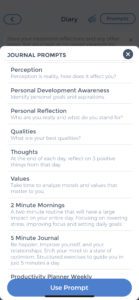 A therapy journal is a tool that can be used to journal your thoughts and feelings related to your therapy. It can be used to track your progress, document your goals, and reflect on your experiences. journaling can be a helpful way to process difficult emotions and promote self-awareness.
A therapy journal is a tool that can be used to journal your thoughts and feelings related to your therapy. It can be used to track your progress, document your goals, and reflect on your experiences. journaling can be a helpful way to process difficult emotions and promote self-awareness.
Table of Contents
- Why is journaling beneficial for therapy?
- How do I mentally prepare for therapy?
- Why does my therapist want me to journal?
- How do you keep therapy session notes?
- How often do you record entries in a therapy journal?
- What are guided therapy prompts?
- What is your therapy goal?
- What are the barriers to change?
- Can you use the journal if you already go to therapy?
- What kind of therapies does this journal support?
- Does this notebook replace therapy?
- What is reframing and how do I use it when journaling?
- Why use a digital therapy journal app over a physical notebook?
- Provide relief to your mental health with a therapy journal
Why is journaling beneficial for therapy?
Journaling can be a helpful way to process difficult emotions and promote self-awareness. journaling can help you to understand your thoughts and feelings and can provide insight into your behavior. Journaling can also help you to set goals and track your progress. Journaling can be a useful tool for managing stress, anxiety, and depression based on the fact that it can help you to process your thoughts and feelings.
When journaling, it is important to be honest and open with your thoughts and feelings. Journaling can be a safe place to express your thoughts and feelings without judgment. Journaling can also help you to identify patterns in your thoughts and behaviors.
How do I mentally prepare for therapy?
Mentally preparing for therapy can be a helpful way to get the most out of your sessions. It can be helpful to spend some time journaling before your first session. This can help you to identify the topics you would like to discuss in therapy. It can also be helpful to reflect on your goals for therapy and what you hope to accomplish.
Some people may feel nervous or anxious about starting therapy. This is normal and to be expected. It can be helpful to remember that therapy is a safe space to talk about your thoughts and feelings. Your therapist will be there to support you and will not judge you.
Why does my therapist want me to journal?
Your therapist may want you to journal for a number of reasons. Journaling can be a helpful way to process your thoughts and feelings related to therapy. It can also help you to track your progress and reflect on your experiences.
A number of studies have found journaling to be beneficial for mental health. One study found that journaling was associated with reductions in stress, anxiety, and depression (Pennebaker, 1990). Another study found that journaling was associated with improved immune function (Benson, 1996).
How do you keep therapy session notes?
There are a few different ways that you can keep notes from your therapy sessions. Some people prefer to write down their thoughts and feelings after the session. Others may prefer to record the session. Some people find it helpful to do both.
If you choose to write down your thoughts and feelings, you can use a journal or an app like CareClinic. It can be helpful to set aside some time after each session to write down your thoughts and feelings. This can help you to process the session and reflect on what was discussed and not forget the details.
Structure to keep therapy session notes
If you choose to record your therapy sessions, it can be helpful to have a set structure for your notes. This can help you to organize your thoughts and reflect on the session. Some people prefer to write a summary of the session.
Others may prefer to write down key points or themes. Some people find it helpful to create a mind map of the session. A mind map can be a helpful way to visualize the topics discussed and how they are connected. Record key takeaways and action items from each session. This can help you to remember what was discussed and identify what you need to work on.
What is a self-reflection component in journaling?
Self-reflecting on your thoughts and feelings can be a helpful way to journal. This can help you to understand your thoughts and emotions and identify patterns in your behavior. Usually, self-reflection happens after you have written down your thoughts and feelings.
How do you start a journal for therapy?
You can start each journal entry by taking a deep breath and perhaps putting on noise-canceling headphones. Once you are “in the zone” and in “zen”, you can begin to write your journal entry. Start by answering the question “How are you feeling right now?” on a scale of 1 to 10, 10 being amazing. You may do this directly in the Mood tracker on CareClinic or write it out in free form in the Diary.
Follow this with your session notes which we mentioned above and then your top 5 key takeaways from the therapy session so you can reflect back. Remember, don’t expect just one writing session to “cure” you. This is a lifelong habit that will pay dividends!
If you are feeling stuck, you can always look back through your previous journal entries for inspiration. It can be helpful to reread your entries from a different perspective. This can help you to see your thoughts and emotions from a different perspective and understand them in a new way.
How often do you record entries in a therapy journal?
If you have therapy weekly then you can record your thoughts and feelings after each session. If you have therapy less frequently, you can record your thoughts and feelings as they come up. You can also set aside some time each week to reflect on your thoughts and emotions.
What are guided therapy prompts?

-What are you feeling today?
-What are your thoughts about (insert topic)?
-What are your goals for therapy?
-What did you discuss in therapy today?
-How do you feel after the therapy today?
-What are your action items from therapy today?
Therapy journaling can be a helpful way to process your thoughts and emotions. It can also be a helpful way to prepare for therapy and keep track of your progress. Using therapy prompts can help you to get started with journaling.
CareClinic comes with built-in guided prompts to help you get started, these can be accessed from the top right side of the Diary screen. You can also add and save your own “most used” prompts if you catch yourself using them often.
What is your therapy goal?
Some people may choose to start therapy with a specific goal in mind. Others may not have a specific goal and that is okay too. If you do have a goal, it can be helpful to write it down in your journal. This can help you to track your progress and see how far you have come. If you don’t have a specific goal, that’s okay too. You can still use journaling to track your thoughts and emotions. This can help you to identify patterns in your behavior. You may find that a goal develops over time as you journal.
What are the barriers to change?
There may be some things that stand in the way of you achieving your therapy goals. These are called barriers to change. It can be helpful to identify these barriers in your journal. This can help you to find ways to overcome them. Some examples of barriers to change include:
- Fear
- Anxiety
- Depression
- Anger
- Addiction
- Relationship problems
- Low self-esteem
- Trauma
These are just some examples of barriers to change. You may have other barriers that are unique to you. It can be helpful to identify these barriers in your journal so that you can find ways to overcome them.
What are the steps to change?
There are usually four steps that people go through when they are trying to make a change. These steps are:
Precontemplation: This is the stage where you are not considering making a change.
Contemplation: This is the stage where you are considering making a change.
Preparation: This is the stage where you are preparing to make a change.
Action: This is the stage where you are actively making a change.
It can be helpful to identify which stage you are at in your journal. This can help you to find ways to move forward.
What are the relapses?
A relapse is when you return to old habits or behaviors. This can happen after you have made a change. It is important to remember that relapses are normal. They do not mean that you have failed. It can be helpful to journal about your relapses. This can help you to identify the triggers that led to the relapse. It can also help you to find ways to prevent future relapses.
What are the triggers?
Triggers are things that can lead to a relapse. They can be internal or external. Internal triggers are thoughts or emotions that lead to a relapse. External triggers are things in the environment that lead to a relapse. It can be helpful to identify your triggers in your journal. This can help you to find ways to prevent future relapses.
Can you use the journal if you already go to therapy?
Yes, you can use the journal even if you already go to therapy. It can be a helpful way to prepare for therapy and keep track of your progress. It can also be helpful to use the journal in between sessions to process your thoughts and emotions.
What kind of therapies does this journal support?
The journal supports all kinds of therapies. This includes, but is not limited to Cognitive Behavioral Therapy (CBT), Dialectical Behavior Therapy, Acceptance and Commitment Therapy, Psychodynamic Therapy, and Solution Focused Therapy. The journal can be used with any kind of therapy as it is a free-form diary with access to prompts.
Does this notebook replace therapy?
No, this notebook does not replace therapy. It is a tool that can be used to supplement therapy.
If you are thinking about starting therapy, please consult with a mental health professional to find the right treatment for you. If you are in crisis, please call the National Suicide Prevention Lifeline at 1-800-273-8255 or text “HOME” to the Crisis Text Line at 741-741.
What is reframing and how do I use it when journaling?
Reframing is a technique that can be used to change the way you think about something. It can be helpful to use reframing when journaling about a difficult experience. This can help you to see the situation in a new light. For example, if you are journaling about a fight with a friend, you could reframe the situation by thinking about what you learned from the experience. This can help you to see the situation in a more positive light.
Here are some tips for using reframing when journaling:
-Identify the situation that you want to reframe.
-Think about how you want to feel about the situation.
-Think about what you want to learn from the situation.
-Write about the situation in your journal using the new perspective.
Why use a digital therapy journal app over a physical notebook?
It’s Your Therapy Journal Online
There are many benefits to using a digital therapy journal. One benefit is that you can access it from anywhere, anytime given you have your mobile device or access to the web. It will work on any tablet, or smartphone running Android or iOS.
It is safe and secure
Another benefit of using a digital therapy journal is that it can be more private than a notebook. With a digital journal, you can password-protect all your entries. This can be helpful if you are worried about someone reading your journal.
It is searchable, structured and provides correlations automatically
Finally, a digital journal can be more organized than a notebook. You can use other trackers to structure your entries and filters to help you find entries more easily (with correlations). You can also add photos to easily remember a memory at the time of writing.
It comes with built-in prompts, so you can start quickly
The app also comes with built-in prompts to help you get started with journaling. If you are feeling stuck, you can use a prompt to help you get started. You may also add and store your own prompts!
Print only what you need for sessions
You can always export your entries as a CSV or PDF and store them in a physical journal. You may also choose to print charts and correlations related to your mood and other factors to provide your therapist with a full overview of your treatment progress.
Provide relief to your mental health with a therapy journal
CareClinic’s diary functionality can be used as a guided space for reflection during or post-therapy sessions. You can use it to record events, moods, thoughts and emotions related to those events. You can also add photos, set reminders, and password-protect your entries. The app comes with journaling prompts, but you can also create your own. You can use the app to supplement any kind of therapy, including Cognitive Behavioral Therapy, Dialectical Behavior Therapy, Acceptance and Commitment Therapy, Psychodynamic Therapy, and Solution Focused Therapy.
You can use the journal as needed to help you identify goals and track your progress. Recording your thoughts and emotions can help you to see patterns and triggers. This can be helpful in understanding yourself better and making changes. The app is free to download and try, so why not give it a go?



